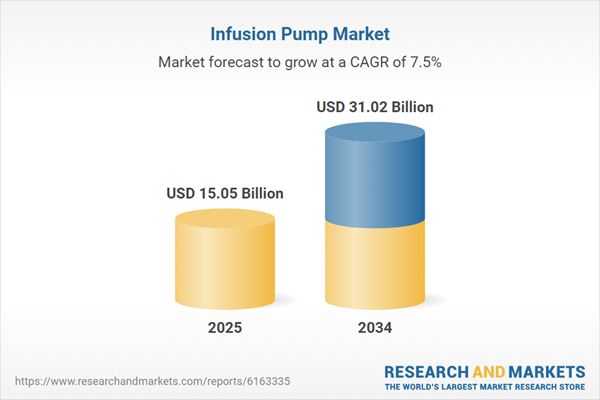Infusion Pump: Introduction
An infusion pump is a medical device that is used to deliver fluids such as nutrients and medications, into a patient's body in controlled way and doses. Infusion pumps are widely used in clinical settings such as hospitals, nursing homes, and in homes as well. Infusion pump is generally operated by a skilled user, who set device settings such as rate and duration of fluid in a way that it delivers the fluid based on those settings only. This programming is being done by the help of built-in software interface in the infusion pump devices. Infusion pumps have several advantages in comparison to manual administration of fluids such as delivering fluids even in the smallest volumes, and the ability to program the delivery of fluids based on rate or certain automated intervals.Infusion pumps can deliver nutrients or medications, such as insulin, antibiotics, chemotherapy drugs, among others. The wide range of infusion pumps include pumps with large volume, patient-controlled analgesia (PCA), elastomeric, syringe, enteral, and insulin pumps. Some are designed mainly for stationary use at a patient's bedside. Ambulatory infusion pumps are other kind of infusion pumps that are portable by design. To keep the patient's safety as a priority, some infusion pumps have embedded safety features such as alarms that are supposed to get activated on their own if any emergency occurs. For example, some pumps are designed to send alert to the user when any sort of blockage or trapped air is detected in the tube which delivers fluid to the patient. Newly developed advanced infusion pumps which are also called smart pumps are designed to alert the user when there is a potential risk of an adverse drug interaction. Automated drug delivery, precision dosage, avoiding medication errors, and reducing the workload of nursing staff are some of the advantages that infusion pumps provide.
Global Infusion Pump Market Analysis
The increased demand for ambulatory infusion pumps due to the compact size and other features such as being user friendly, and technologically advanced is a market trend owing to the market growth. With ambulatory infusion pumps, the patient has the freedom to even move around while receiving their infusions. This convenience can improve patient's quality of life and can also support home healthcare.Additionally, the increased focus on patients' safety is increasing the preference towards smart infusion pumps that have features like dose error reduction software, propelling the infusion pump market expansion. With the help of these systems, prevention of medication errors can be done which is an important issue in healthcare areas. Increased integration of infusion pumps with electronic health record (EHR) systems that makes it easier for the healthcare professionals to record the activity of the medication administration and patients' response. With the convenience it provides along with patients' safety, the adoption of home healthcare is increasing and driving the demand for home-use infusion pumps.
Global Infusion Pump Market Segmentations
Infusion Pump Market Report and Forecast 2025-2034 offers a detailed analysis of the market based on the following segments:Market Breakup by Type
- Accessories
- Devices
- Volumetric
- Insulin
- Syringe
- Ambulatory
EnteralMarket Breakup by Technology
- Traditional
- Specialty
Market Breakup by Applications
- Cancer
- Diabetes
- Pediatric
Market Breakup by Region
- North America
- Europe
- Asia Pacific
- Latin America
- Middle East and Africa
Global Infusion Pump Market Overview
The increasing prevalence of chronic diseases such as diabetes, cancer, and gastrointestinal disorders that require frequent or continuous administration of medications are rapidly driving the global infusion pumps market growth. The increasing technological advancement in the development of infusion pumps is also driving the market. These highly advanced infusion pumps provide safety features with being portable and connectable as well. With such advancements the efficiency and effectiveness of drug delivery is increasing which is directly propelling market growth.Additionally, the rise in geriatric population globally is contributing to the market growth as the geriatric population is more susceptible to chronic diseases and require hospitalization more often. This rise in geriatric population has increased the need for infusion pumps in different treatments. The increasing healthcare expenditure globally, especially in emerging economies has increased the demand for demand for advanced medical devices including infusion pumps.
Global Infusion Pump Market: Competitor Landscape
The key features of the market report include patent analysis, grants analysis, clinical trials analysis, funding and investment analysis, partnerships, and collaborations analysis by the leading key players. The major companies in the market are as follows:- Becton, Dickinson and Company
- Baxter International
- B. Braun Melsungen AG
- ICU Medical
- Medtronic plc
- Avanos Medical, Inc.
- Nipro Corporation (Japan)
- Mindray Bio-Medical Electronics co., Itd.
- Geräte GmbH & Co KG
- Ypsomed Holding AG
This product will be delivered within 3-5 business days.
Table of Contents
Companies Mentioned
- Becton, Dickinson and Company
- Baxter International
- B. Braun Melsungen AG
- ICU Medical
- Medtronic plc
- Avanos Medical, Inc.
- Nipro Corporation (Japan)
- Mindray Bio-Medical Electronics co., Itd.
- Geräte GmbH & Co KG
- Ypsomed Holding AG
Table Information
| Report Attribute | Details |
|---|---|
| No. of Pages | 350 |
| Published | July 2025 |
| Forecast Period | 2025 - 2034 |
| Estimated Market Value ( USD | $ 15.05 Billion |
| Forecasted Market Value ( USD | $ 31.02 Billion |
| Compound Annual Growth Rate | 7.5% |
| Regions Covered | Global |
| No. of Companies Mentioned | 10 |









